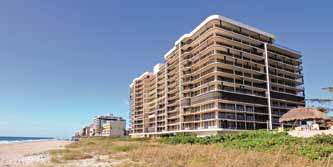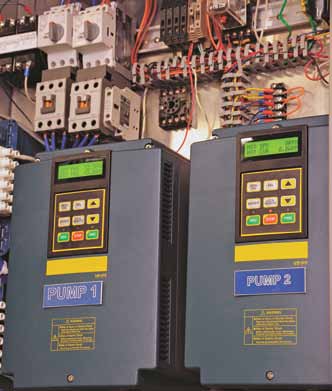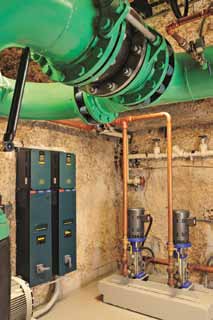Significant energy and money savings are realized when using variable speed motors controlled with drives.
The Villa Magna, a 92-unit luxury condominium in Highland Beach, Fla., sits between the Atlantic Ocean and the Intracoastal Waterway. When a major maintenance program was due to be carried out at the 30-year-old high-rise, the Villa Magna condominium association approached repairs as a unique opportunity to improve the efficiency of systems to conserve water and energy. The results of their efforts have not only benefited their budget but also the environment.

By replacing fixed speed pump motors with variable speed drives and motors, Villa Magna has a more reliable system that is saving electricity and water. These changes, along with the installation of solar panels, heat pumps, energy-efficient lighting and appliances, has earned Villa Magna a great deal of recognition, including the 2010 Florida Communities of Excellence Award for Energy and Water Conservation.
Problems with the Current Setup
Bresnak Services Inc., a company that specializes in pumping systems for boosting water pressure in high-rise buildings, did the work on a new domestic water supply system and an air conditioning condensation collection system at the condo. Gary Bresnak, managing director for Bresnak Services, says that after investigating the existing water supply and air conditioning systems, he concluded that the primary problem with both was their lack of controllability.
The system for boosting the pressure of the water supply, which is a common feature in high-rise buildings, used two 25-horsepower pump motors running at full speed for 24 hours per day. The motors consumed 19 amps continuously, regardless of water demand. Pressure was controlled by mechanical regulators, an inefficient system that required regular and expensive maintenance. Since modern domestic appliances are considerably more water efficient, Bresnak also judged the existing system to be far too large for what was required.
The New Configuration
For a more efficient and reliable solution, Bresnak replaced the fixed-speed, 25-horsepower motors with 10-horsepower variable speed motors controlled by drives. “The drives' V/Hz control mode enables motor speed to be controlled by feedback from a pressure sensor, to maintain constant water pressure under different flow rates,” explains Bresnak. “A time switch sets the duty cycle of each pump to 12 hours, to maximize reliability. Each motor consumes just 5.8 amps, which is less than a third of the energy demanded by the previous system.”

By using drives to control the domestic water system in the high-rise building, residents now have constant water pressure despite usage.
The condominium's air conditioning system was equally inefficient. Water is pumped through heat exchangers in each of the building's apartments and then fed via a roof-mounted cooling tower before being sent back into the system. Bresnak found that the existing pump system used two 40-horsepower motors running at full speed from the 60-Hz supply, which consumed 80 amps. He also discovered that the flow rate was far too high, resulting in a temperature drop of only a few degrees in the cooling tower.
“By retrofitting the condenser pumps with motors and bypass pump drives, we can now run the pumps at 50 Hz,” explains Bresnak. “The result is that the current consumption has been dropped from 80 amps to 53 amps. Plus, we have been able to lower the flow rate to the point where there is now as much as 10 degrees of heat loss in the cooling tower, rendering the entire building's air conditioning system much more efficient.”
Another part of the project involved an air conditioning condensation collection system to help conserve water, a particularly valuable commodity in Florida. Instead of losing condensation down the drain, it is now collected in a 400-gallon tank and then recycled back into the tower to further aid cooling. Bresnak says the goal is to introduce the cold water into the cooling tower at a slow rate.
“Again, my solution was to use another bypass pump drive for the multistage pump,” says Bresnak. “By providing this very slow speed control, we can match the usage rate with the collection rate. This kind of control allows us to slowly add the water as the cooling tower needs it without overflowing the tower and wasting any water.”

Ten-horsepower variable speed motors controlled by drives were selected for the system to maintain constant water pressure under different flow rates.
Bottom Line Results
Frank Strachan, Villa Magna's building manager, is pleased with the results. “The work carried out by Bresnak Services is saving us approximately $2,000 a month on our water bill,” says Strachan. “Over the last 12 months, we have also saved about $24,000 on electricity. These figures are considerably better than those achieved by some energy-saving schemes in other areas and say much for Bresnak's ability to apply Baldor variable speed technology so knowledgeably.”
Strachan says the savings achieved so far have more than paid for the motors and drives. Now, with the investment paid for, he says he is looking forward to years and years of more savings.
“Saving energy and water is the right thing to do, and being green makes you feel good,” says Strachan. “But it also feels good to save money. This has been a win-win because we are conserving our water resources and using less electricity.”
Bresnak says, “I have a good relationship with the drives engineers. [They treat] me as their partner and understand that I can't have any problems out in the field. Whenever I call to talk through issues and need help, I get it, and that's why I continue to choose [these] products.”
Pumps & Systems, October 2011

